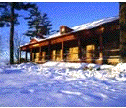






















|
|
Features of Turbulence Kolmogorov Scales Large-scale turbulent motion is roughly independent of viscosity.
The small-scale, however, is controlled by viscosity. The small-scale motions are also
statistically independent of relative slow large-scale turbulent fluctuations
(and/or mean motions). According to Kolmogorov (Universal Equilibrium Theory), the
small-scale turbulence is in equilibrium (independent of large-scale) and is
controlled solely with
Using equation (1), from (5) it follows that
For a dissipation rate of |


|


 and
and
 . Using dimensional
arguments, Kolmogorov defined the length, time, and velocity scales of the smallest eddies
of turbulence. These are
. Using dimensional
arguments, Kolmogorov defined the length, time, and velocity scales of the smallest eddies
of turbulence. These are
 ,
,
 ,
,
 .
.
 ,
,
 ,
,
 .
.
 of
water,
of
water,  .
.